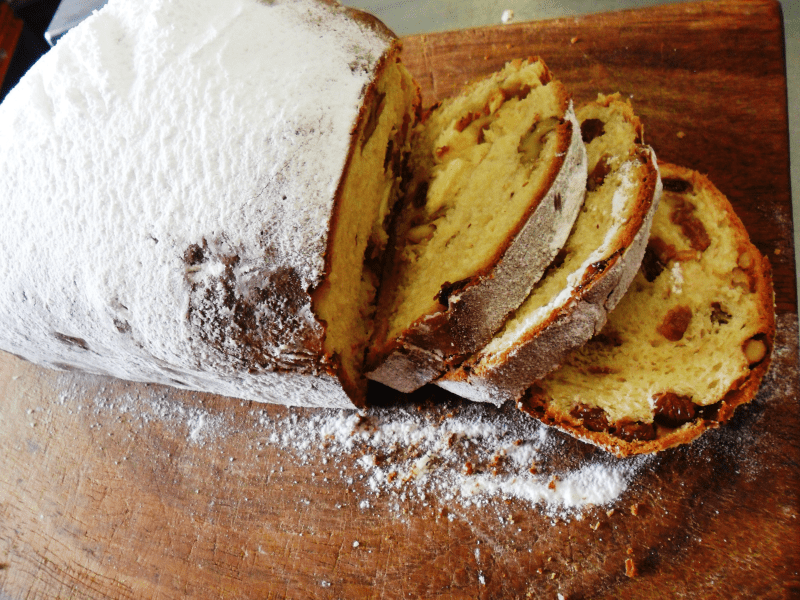Community Chef, Robin Van Creveld, has helped thousands of people improve their cookery and nutrition skills. Robin has held baking and cooking workshops for carers during the year and here he gives his recipes for Christmas breads, Stollen, and Greek Christmas bread, Christopsomo.
Stollen
Robin says, “Stollen is a classic German Christmas bread, usually associated with Dresden. The dough is usually made with low gluten flour and is enriched with butter sugar, egg and alcohol and spice infused fruit. This type of stollen usually has a thick vein of marzipan running through it. The yeast percentage is slightly higher than a standard dough as the milk, butter and egg slow down the fermentation. Bake at a lower temperature than most dough as the high fat and sugar content makes burning more likely.”
Ingredients
300g plain white flour (more for dusting)
125g/ml warm milk
5g dried yeast
5g salt
1 egg
50g sugar
50g butter
150g marzipan
Fruit for stollen to be mixed in advance
125 mixed dried fruit
50ml whiskey and 75ml wine or orange juice
5g cinnamon powder and 2g cardamom powder
25g almonds, chopped
50g butter (melted)
For the glaze, slowly bring to the boil the following:
30g apricot Jam, 45g butter, 30g sugar and 15ml, milk
To finish: Icing sugar or sugar nibs
Method
Stage 1: Sponge. In a large bowl mix together the milk, yeast, sugar and 100g flour. Mix, cover and ferment for 120 minutes.
Stage 2: Dough and Ferment. Rub the butter into the remaining flour, add the salt and mix together with the sponge and egg to form a soft dough. Turn this out onto a dry surface and knead for 5 minutes. It is sticky dough, so work it quickly with wet or oiled hands. Put this back into the oiled bowl, cover with a damp tea towel or a plastic bag and allow it to rise in a warm place for 90–120 minutes.
Stage 3: Forming, proofing and baking. Turn out the dough onto a lightly floured surface and press or roll out the ball to an oblong 20 x 30cm with the longer side facing away from you. Sprinkle the fruit and nuts over 2/3rd of the dough and gently press into the dough. Using your hands, roll the marzipan into a sausage about 20cm long. Place this at the bottom of the dough nearest you. Roll up the dough and place seam side down with the edges gently tucked under and place seam side down onto an oiled and dusted baking sheet. Leave it to prove in a warm place until it has doubled in size again, then bake at 170’c for 35-40 minutes.
Stage 4: Glaze and decorate. Transfer to a wire rack and brush repeatedly with melted butter.
When it is completely cool then brush with the apricot glaze and dust with a lot of icing sugar or sugar nibs.
Christopsomo
Robin says, “This is a Greek Christmas bread – the dough is enriched with butter, milk, sugar, eggs and mixed peel. Some people add wine or ouzo to the dough for an even more flavoursome loaf. The traditional practice when making this bread is to knead all of your hopes, aspirations and intentions for the New Year into the dough and to spend the time it takes to ferment and rise, contemplating the year just gone. Baking it and sharing it with your nearest and dearest ensures that your hopes for the New Year come to fruition. Some people decorate the loaf with personal symbols or motifs made from extra dough and whole walnuts.”
Ingredients
300g strong white flour
100g/ml warm milk
5g dried yeast
5g salt
1 egg
50g sugar
50g butter, softened
150g candied citrus peel
1tsp crushed anise seeds or ½ tsp crushed fennel seed
½ tsp crushed cloves
½ tsp grated nutmeg
Egg for glazing
Method
Stage 1: Sponge. In a large bowl mix together the 100g milk, yeast, sugar and 100g flour. Mix, cover and ferment for 120 min.
Stage 2: Dough. Mix all of the remaining ingredients together with the sponge to form wet sticky dough, Leave this for 10 minutes before kneading it to smooth and elastic dough. Place into an oiled bowl, cover and allow to ferment for 2-3 hours.
Stage 3: Forming and proving the loaf. Gently de-gas the dough and cut off about 50g of dough to use later. Now form the dough into a round shape. Flatten the dough slightly and imagine a clock and take the edge (or ear) at 12 o’clock and stretch it out a bit and fold it into the centre. Crimp this down and repeat at 3, 6 and 9 o’clock. Now repeat with the other 4 ears. Now turn this over so that the crimps are below and draw the dough towards you, but don’t let it roll. This will tighten up the ball further. Continue doing this in a circular motion until you have a proud ball of dough. Place onto a baking tray and cover with a cloth or place the tray into a plastic bag and allow it to proof until doubled in size.
Stage 4: Decorating and baking. At this stage, take your extra dough and roll it out to form a long sausage. Use this to form a cross over the ball, tucking in the ends under the main dough. You can also use the dough to form symbols personal to you and your family and stick them onto the main dough with egg wash. Brush the whole thing with egg and bake in an oven pre-heated to 200’c for 5 minutes, then lower the temperature to 175’c and bake for a further 30 minutes. Allow to cool fully before eating.
Thanks to Robin for sharing his recipes. Robin is running a Stollen workshop on Monday 6th December, more information here. It’s free for carers (there is a small booking fee that is refundable upon attendance). Robin runs many other baking and cooking workshops, more information on his website here.




